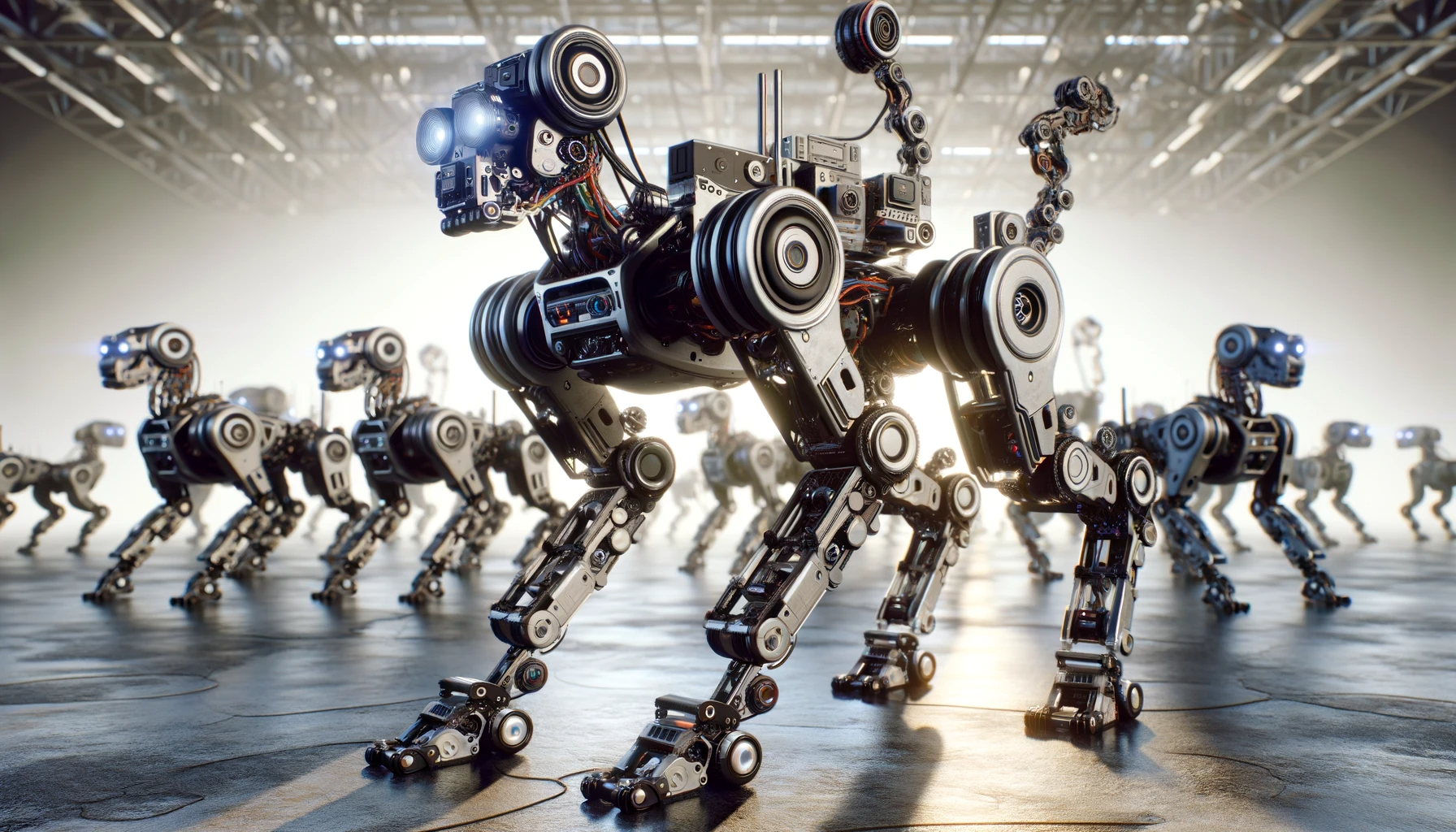In a paper published in the journal Scientific Reports, researchers presented an innovative adaptive locomotion system for quadruped robots. The system employed a double-layered central pattern generator (CPG) based on gyroscope signals for yaw and pitch angles. With dual master units controlling the first joints and slave units governing the second and third joints, the CPG network enabled seamless gait transitions and precise movement control.
 Study: Revolutionizing Quadruped Robot Locomotion: An Adaptive System Based on Double-Layered Central Pattern Generator. Image credit: Generated using DALL.E.3
Study: Revolutionizing Quadruped Robot Locomotion: An Adaptive System Based on Double-Layered Central Pattern Generator. Image credit: Generated using DALL.E.3
An integrated ultrasonic sensor facilitated smooth stops and starts. The paper also proposed adjustments in mutually dependent parameters for steering behavior and suggested stable ranges for body yaw and pitch angles to adapt to irregular surfaces. Experimental results confirmed the quadruped robot's ability to perform a regular trot pattern in complex environments.
Background
In quadruped robotics, versatility in unstructured terrains is a distinctive advantage over wheeled counterparts. Various control methods, including model-based, compliant, and CPG approaches, have been explored for tasks like walking and steering. Model-based control calculates mechanical characteristics, while compliant control enhances adaptability through feedback. Influenced by biological CPGs, researchers have devised multi-layered networks for active hierarchical sensory information processing. Researchers have utilized neural oscillator techniques and the trot movement pattern to leverage biomimetic locomotion.
Quadruped Robot Control and Adaptive Locomotion
Quadruped Robot Model: The Standford Pupper quadruped robot operates with 12 degrees of freedom and has three active joints per leg, comprising the first pitch joint, second yaw joint, and third yaw joint. The second and third joints, powered by steering actuators, are pivotal in propelling the robot forward. Servo CL S6336HV servomotors, utilizing serial communication buses, control the joints, while an ultrasonic sensor aids in obstacle detection during movement.
A gyroscope sensor is embedded inside the robot to gauge body angles, providing feedback on yaw, pitch, and roll angles. Addressing challenges to motion stability, the compact dimensions of the robot (20 cm height, 33 cm length, and 1.65 kg weight) prompt the implementation of stability constraints based on the center of gravity and the supporting polygon.
Model of CPG Unit: Researchers have introduced a CPG unit model for trot pattern movement, featuring excitatory and inhibitory units generating periodic signals based on coupling parameters. These units contribute to real-time joint angle generation, with dynamic parameters influencing motor behavior. The gyroscope provides feedback on body angles, while an ultrasonic sensor adjusts the CPG model based on environmental stimuli. This adaptive rhythmic joint motion facilitates the robot's ability to overcome diverse terrain conditions.
Model of CPG Network: In the CPG network model, mounted on each leg of the quadruped robot, double master units (controlling first joints) and slave units (containing second and third joints) form the network. Mutual dependencies between parameters, such as yaw and pitch angles, enable coordinated control. The network generates stable oscillation states, producing periodic signals crucial for trotting motion. Steering behavior is achieved through mutually dependent parameters, allowing the robot to adapt its gait in response to external stimuli and obstacles. The response of the CPG network is finely tuned, maintaining coordination constraints during steering motions.
Limit Cycle and Gait Switch: A designed limit cycle facilitates stable periodic signals in the CPG model, defining exact repetitions with a closed trajectory for trotting. The manipulation of amplification and frequency adjusts the signals to control the quadruped robot. The CPG network exemplifies its ability to change gait patterns through the gait switch, wherein parameters like feedback and gain constants influence the network's response. This capability ensures the quadruped robot can generate suitable motions and adapt to varying environmental conditions.
Steering Behavior and Parameter Adjustment: By setting mutually dependent parameters, such as feedback and gain constants, the CPG network generates joint angles for steering behavior. The coordination constraints imposed by couplings are respected, with the robot demonstrating adaptive trotting patterns. The phase differences between output signals, determined by internal parameters and network topology, ensure coordinated movements. Adjustments in feedback parameters further refine the CPG network's response, demonstrating its adaptability and effectiveness in generating periodic signals for responsive and controlled quadrupedal locomotion.
CPG Network Validation in Quadruped Locomotion
To validate the adaptive movement system for quadruped robot control, researchers conducted two experiments to assess the CPG network's efficacy. The initial experiment showcased the robot's trotting and steering capabilities using an ultrasonic sensor, with the CPG network autonomously generating periodic signals for obstacle adaptation and navigation through confined spaces.
The second experiment involved the quadruped robot navigating a rough surface with up-down slopes, adjusting parameters based on gyroscope signals for real-time feedback. This adaptive response, observed through joint angles and body movements, highlighted the practicality and versatility of the proposed double-layered CPG network for diverse real-world applications.
Conclusion
To sum up, this study presents a model of the CPG unit, incorporating motor dynamics parameters for quadruped robot control. Proposing to enhance the robot's adaptability across various scenarios, researchers introduce an adaptive locomotive system featuring a double-layered CPG network. Utilizing gyroscope signals for yaw and pitch angles, the CPG network, comprising double master units and subsets of slave units, generates periodic signals to control leg joints effectively.
The interconnected enslaver and enslaved person CPG models ensure stable movement, with master units controlling the first joints and slave units generating symmetry signals for the second and third joints. Two experiments confirm the proposed control system's validity by demonstrating its efficacy in achieving stable motion patterns in diverse environments.